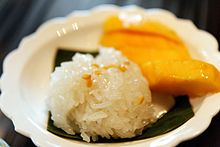Mango sticky rice: Difference between revisions
No edit summary Tags: Reverted Mobile edit Mobile web edit |
Undid revision 1144133462 by Zack classber025300 (talk). "One of the desserts that is impossible to miss in Cambodia is bey dom neib, mango and sticky rice." (https://foodfuntravel.com/cambodian-cuisine-discover-the-most-popular-dishes-drinks/) Tag: Reverted |
||
| Line 7: | Line 7: | ||
| country = |
| country = |
||
| region = [[Southeast Asia]] and [[South Asia]] |
| region = [[Southeast Asia]] and [[South Asia]] |
||
| national_cuisine = [[Lao cuisine|Lao]], [[Filipino cuisine|Filipino]], [[Thai cuisine|Thai]], [[Vietnamese cuisine|Vietnamese]] |
| national_cuisine = [[Cambodian cuisine|Cambodian]], [[Lao cuisine|Lao]], [[Filipino cuisine|Filipino]], [[Thai cuisine|Thai]], [[Vietnamese cuisine|Vietnamese]] |
||
| creator = |
| creator = |
||
| course = [[Dessert]] |
| course = [[Dessert]] |
||
Revision as of 23:07, 13 March 2023
 Mango sticky rice | |
| Type | dessert |
|---|---|
| Course | Dessert |
| Region or state | Southeast Asia and South Asia |
| Associated cuisine | Cambodian, Lao, Filipino, Thai, Vietnamese |
| Main ingredients | Sticky rice, mango, coconut milk |
Mango sticky rice is a traditional Southeast Asian and South Asian dessert made with glutinous rice, fresh mango and coconut milk, and eaten with a spoon or the hands.[1]
Preparation
Usually desserts involving sticky rice are sweetened with palm sugar or jaggery combined with coconut milk and coconut flakes, wrapped in banana leaf, then steamed or stuffed in bamboo and roasted on an open fire such as sticky rice in bamboo.[2] The main ingredients needed are sticky rice (glutinous rice), canned or fresh coconut milk, salt, palm sugar and mangoes.
To prepare the dish, the rice is soaked in water and then cooked by steaming or the use of a rice cooker. Meanwhile, the coconut milk is mixed with salt and sugar then heated without boiling. After the rice is finished cooking, the coconut milk mixture and the rice are mixed together evenly and allowed to sit to allow the milk to absorb into the rice. The mangoes are peeled and sliced. To serve the dish, the rice is scooped onto a plate, a few mango slices are placed on top or to the side, and the remaining coconut milk is drizzled on top. Sometimes, the sticky rice is topped with crispy yellow mung beans.[3]
Mostly, yellow mango is used which has a sweeter taste than green mango. Traditionally, the Nam Dok Mai (flower nectar mango) and ok-rong varieties of mango are used.[4] Glutinous sticky rice, which is sweeter than the normal sticky rice, is used for the best texture.[3]
Variations
These are variations to the classic mango sticky rice, such as substituting white sticky rice with black sticky rice, imparting a purple color.[5]
In Thailand
Mango sticky rice is a common street food in Thailand and is considered an attractive factor by foreigner tourists for travelling in Thailand.[6] It is usually eaten during the peak mango season of April and May.[7] Common sweet mango cultivars, such as nam dawk mai or ok long, are combined with glutinous rice sweetened with coconut milk, and served warm.[7]
In Laos
Mango sticky rice is a common dessert of the Lao people of the Greater Mekong Sub-region[citation needed] where glutinous rice has been cultivated over the history of food and myths.[8][9] Sticky or glutinous rice is a Laos national dish connected to the culture and religious traditions.[10][11][12] In mango-ripening season, sticky rice garnished with sweetened coconut milk and dry roasted sesame seeds is served with ripe mango pieces. Sticky rice may be served plain with only mango and no trimmings.[13]
In the Philippines
A sticky rice snack cooked in coconut milk, and sometimes, ginger called puto maya is a favorite among the Visayan people. It is served with sweet ripe mangoes (if in season) and a hot chocolate.[14][15] In Cagayan de Oro, a violet variety of sticky rice is used.[16]
See also
References
- ^ "What Is Mango Sticky Rice?". wiseGEEK. Retrieved 29 May 2015.
- ^ The Foreign Missionary. Mission House. 1876.
- ^ a b "Thai Mango Sticky Rice Recipe". Mark Wiens. 6 July 2016. Retrieved 6 March 2017.
- ^ "สนามข่าวชวนกิน : พาไปชิม! ข้าวเหนียวมะม่วง ป้าใหญ่ ป้าเล็ก". Channel 7 (in Thai). 2018-03-10.
- ^ "Coconut Milk Sticky Rice with Mangoes". Epicurious.com. 16 May 2006. Retrieved 21 December 2017.
- ^ Sudjaroen, Yuttana; Petcharaporn, Kanyapat (2021). "Identity and Competitiveness of Thai Street Food Located In Travelling Area of Bangkok". Review of International Geographical Education Online. 11 (7): 4181–4186. doi:10.48047/rigeo.11.07.385 (inactive 31 December 2022). ISSN 2146-0353.
{{cite journal}}: CS1 maint: DOI inactive as of December 2022 (link) - ^ a b "Mango sticky rice". Taste of Thailand. 2020. Retrieved 19 July 2021.
- ^ Epstein, Steven (1993). Xieng Mieng: cleverest man in the Kingdom, a Lao tale retold by Steve Epstein; illustrated by Anoulom Souvandoune. Vientiane Times.
- ^ Sasson, Vanessa R. (2013). Little Buddhas: Children and Childhoods in Buddhist Texts and Traditions. OUP USA. ISBN 978-0-19-994561-0.
- ^ "A Taste of Sticky Rice, Laos' National Dish". Smithsonian Magazine. Retrieved 2021-07-17.
- ^ "Laos at the crossroads". grain.org. Retrieved 2021-07-17.
- ^ "Rice Landscape Analysis - Feasibility of and opportunities for rice fortification in the Lao People's Democratic Republic | World Food Programme". www.wfp.org. Retrieved 2021-07-17.
- ^ Culloty, Dorothy (2010). Food from northern Laos: The boat landing cookbook (PDF). Galangal Press. p. 173.
- ^ Dizon, Erika (August 16, 2017). "Ever Wonder Why Puto Bumbong Is Violet? (It's Not Ube)". Spot.ph.
- ^ Fernandez, Raymund (December 27, 2013). "Puto maya". Inquirer.net.
- ^ Fenix, Micky (August 26, 2015). "'Puto maya,' 'sikwate,' 'bahal,' 'guinamos'–indigenous finds in a Cagayan de Oro market". Inquirer Lifestyle.

